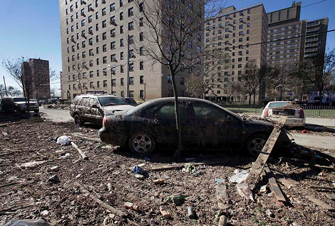Poor, Black and still in the dark
By Saeed Shabazz -Staff Writer- | Last updated: Nov 14, 2012 - 11:04:29 AMWhat's your opinion on this article?

Cars damaged by Superstorm Sandy are surrounded by storm debris in Coney Island, Sunday, Nov. 4, 2012 in New York. Photo: AP Wide World Photos/Mark Lennihan
|
Out of sight of the video arcades and cotton candy way, way down on Surf Avenue live the thousands who inhabit public housing complexes such as Coney Island Houses, with its five 14-story buildings, housing some 1,398 residents. Fifty-one percent of the inhabitants are Black, while 14 percent are seniors over 65-years-old.
Nehemiah Mims, 80, who lives in nearby O’Dwyer Gardens on the 13th floor, left her apartment early the day Hurricane Sandy hit New York. “When Housing knocked on my door and asked was I staying or leaving—I left,” she told The Final Call laughing.
Ms. Mims, like hundreds of others, has found her way each day since the hurricane to the doors of the Coney Island Gospel Assembly at 29th and Neptune Ave. Ms. Mims finds a hot meal and needed supplies for her apartment, which she says still has no power, no heat and no hot water.
The Final Call visited the church Nov. 9, and according to reports, 35,000 public housing residents in Coney Island and Far Rockaway were still in the dark. Many of them had the same complaint that Ms. Mims had: “City not saying nothing.”
The NYC Housing Authority, however, did send out a notice that tenants would receive a rent credit for January due to the lack of services and temporary boilers would arrive by the end of the week.
NYCHA provided numbers of its residents still suffering from the “Superstorm Sandy” to the press on Nov. 12, saying 6,847 residents in 33 buildings in six developments in Coney Island, Red Hook in Brooklyn and Far Rockaway, Queens had no power. Another 18,140 residents in 96 buildings in 14 developments have no heat, nor hot water.
Far Rockaway is home to one of the largest public housing units, the Redfern Houses with 609 units on 19-acres. Other complexes are Beach 41st Street, Edgemere, Hammel and Carleton Manor.
On Nov. 10, some 200 volunteers along with Grammy Award-winning musician John Legend descended on a parking lot in Far Rockaway to distribute clothing, toiletries, and food. Many of the volunteers helped to clean streets and some canvassed buildings door-to-door, checking on the elderly.
Reshma Saujani, a former NYC Deputy Public Advocate, organized the day along with Queen’s activist Erica Ford’s I Love My Life organization and We Care NYC. “In the short term, we will continue helping residents who have lost everything or are continuing without heat and power. But we also need to focus on rebuilding and making sure this community is sustainable over the long-term,” Ms. Saujani said in a press release. “Getting small businesses up and running again is a huge priority—not just for healing the economy but also for lifting the spirit of this community,” she added.
“There is a silent scream in our community to get things back to normal,” said Pastor Connie Hulla, of the Coney Island Gospel Assembly church, as she directed the many volunteers who had come to the church with no lights or heat.
Daquin Deas, 23, came to the church with his little sister and their cart. “We have power in the Gravesend Houses, but no heat or hot water,” Mr. Deas said. “I’m thankful to be alive.”
His family decided to stay and staying allowed him to help an “old lady” who could not walk from drowning as water rose inside her apartment. “If it wasn’t for my neighbors, she would have died,” he added.
Mr. Deas doesn’t know how much longer his stock job will be available. “I have to be there at 5 a.m., and the trains still aren’t going downtown to Manhattan,” he said.
INSIDE STORIES AND REVIEWS
-
-
About Harriett ... and the Negro Hollywood Road Show
By Rabiah Muhammad, Guest Columnist » Full Story -
Skepticism greets Jay-Z, NFL talk of inspiring change
By Bryan 18X Crawford and Richard B. Muhammad The Final Call Newspaper @TheFinalCall » Full Story -
The painful problem of Black girls and suicide
By Charlene Muhammad -National Correspondent- » Full Story -
Exploitation of Innocence - Report: Perceptions, policies hurting Black girls
By Charlene Muhammad -National Correspondent- » Full Story -
Big Ballin: Big ideas fuel a father’s Big Baller Brand and brash business sense
By Bryan Crawford -Contributing Writer- » Full Story






 Click Here Stay Connected!
Click Here Stay Connected!








